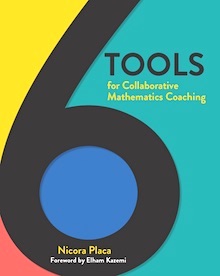Collaborative Coaching to Boost Math Learning
6 Tools for Collaborative Mathematics Coaching
By Nicora Placa
(Stenhouse Publishing, 2023 – Learn more)
Reviewed by Mona Iehl


The six tools include building teams, student interviews, visiting classrooms, learning walks, rehearing routines, and lesson study. You’ll find each one simple to implement and compelling to debrief.
From smart team building to deep dives into classrooms through Lesson Study, Placa’s approach is relatable and approachable. While there are six practices described in the book, two critical themes stood out to me through all six tools. The first was Placa’s take on focusing teachers’ reflections on student thinking, and the second was her focus on adopting a new practice as a team.
Focus on Student Thinking
The most important thing in our math classrooms is to provide students with opportunities to make meaning out of math. We can do that by asking questions to understand their thinking and guiding them with meaningful math experiences. As math teachers we must keep our focus on understanding what our students know, so that we can provide experiences, questions, and tools to help them along their learning journey to math proficiency.
In 6 Tools for Collaborative Mathematics Coaching Placa describes how facilitating adult learning mirrors best practices from our math classrooms. We know that good PD is hard to find and the best way to grow as a professional is to be invested and have ownership over your own learning. Each of the six practices describes a key shift. Placa says, “I shifted my focus from what teachers were doing to what students were doing” (p. 69).
Professional development focused on student thinking allows for teachers to continue to learn and grow while preserving their dignity. When teachers feel honored as hard working, intelligent professionals, they are more engaged and willing to collaborate. Every strategy suggested by Placa makes room for teachers to get curious about students’ thinking in order to reflect on their own practices.
I couldn’t help but put myself in Nicora’s shoes in many of the scenarios. As I step into a full-time role of coaching mathematics teachers, I find that this book aligns perfectly with my teaching, and subsequently, my coaching philosophy. Teachers and coaches shouldn’t create spaces where the learners sit and get, but rather develop experiences where learners explore and discuss in order to better understand.
Placa says, “Spending time to help teachers collaboratively develop a deep understanding about what it means to teach and learn mathematics is more effective than spending time bombarding them with a number of ‘new’ instructional strategies.” The focus on student thinking is one that will create not only better professional development opportunities but also more meaningful math classrooms.
Adopting Something New
This book is not about helping teachers adopt new ideas with more enthusiasm and fidelity. Instead, it provides advice on how to create a culture of learning and curiosity that is driven by teacher teams. When teachers are given the opportunity to ask questions, explore, and discuss questions they are interested in, a community of learners is built. The approach Placa takes is to partner with teachers to build effective practices, not give them one more thing to do.
“Often initiatives fail because we ask people to commit to something for the long term, and we don’t allow room for design changes.” Honoring what teachers bring to the table and listening to their voice are the ways we create collaborative teams.
Placa’s tools can allow coaches to value teachers’ voices while also giving them experiences to grow and learn. Creating conditions to construct understanding, rather than telling the answers, will allow the teachers to authentically adopt new practices.
A new year
This year as I enter into my coaching role, I’m holding onto these words: I will be “shifting from thinking about how I could foster change on my own to how we can learn together” (p.137). I deeply believe in the power of teachers and that through collaborative coaching we can honor the individual gifts of each teacher and facilitate experiences that allow teachers to share for the betterment of all. My role now, as it was in the classroom, is to listen, nudge, ask questions, and provide a safe community to take risks.
If you’re looking for a resource to guide your community of educators in collaborative reflections on math practice, this book will give you the tools – literally six! The six practices will jump off the page with ready-to-use protocols and debrief questions. After stepping out of the classroom to lead, take a note from Placa and be the guide on the side through collaborative coaching.
Mona Iehl (@HelloMonaMath) has been a fifth- and sixth-grade math teacher in Chicago, Illinois. Mona started her 14-year year teaching career in the primary grades but found her home in the middle grades six years ago. In the fall of 2023 she will take on the role of coach. For more details about her teaching methods, visit her website and see her other MiddleWeb posts here.
Mona recently took her passion for helping teachers and students find their inner mathematician to a podcast. Listen in at @HonestMathChat. More fluency resources for multiplication and division systems are available at her Mona Math TPT shop.





























